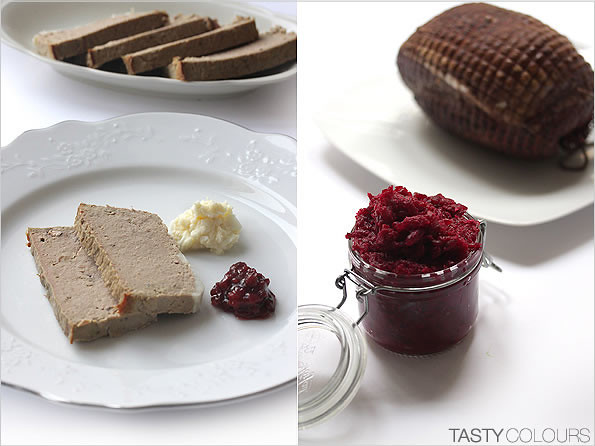The
tradition to make pâtés came to Poland from France a few hundred
years ago. Nowadays they are still an important part of culinary
heritage; pâtés are baked at home, in particular for Christmas and
Easter. Local products like dried mushrooms and spices (typical of
Polish cooking): marjoram, allspice, juniper and bay leaves
are frequently added. Polish pâtés are served cold, cut in slices,
accompanied with horseradish, fruit preserves or tartar sauce. As far
as I noticed, in comparison to French pâtés, Polish recipes usually
call for the smallest amount of alcohol. You may serve the pâté
below cut in slices, accompanied by: lingonberry or cranberry preserves,
sour cucumbers (gherkins) or French cornichons, pickled ceps,
tartar sauce,
horseradish, home-made mayonnaise (for example cranberry mayonnaise)
Home Made Pâté
Makes
2 molds 12 x 25 cm
Ingredients:
700
g boneless
veal
(cheapest piece for baking), cut into 3-4 cm cubes
600
g boneless
quite fat pork,
cut into 3-4 cm cubes
300
raw
bacon,
non smoked, cut into 3-4 cm cubes
500
g chicken
livers
300-350
g back
pork’s fat
(salo), cut into very thin slices
200
ml milk
1
carrot,
peeled and washed
1
root
parsley,
peeled and washed
½
small celeriac,
peeled and washed
1
onion,
peeled, washed and cut into halves
1
garlic
clove,
peeled
30
g dried
ceps
30
g almonds,
blanched, peeled and cut in slices along
30
g walnuts
blanched,
peeled and cut in slices along
1
bread
roll
1-2
cloves
2-3
bay
leaves
5-6
grains black
pepper
2-3
grains allspice
3
pinch nutmeg
5
eggs
100
ml cognac
or brandy
salt
pepper
For
the horseradish:
150
g grated
horseradish
1
hard
boiled egg
2
tablespoons,
heavy cream
salt,
pepper
Prepare
the mushrooms, meat and livers: soak
mushrooms for at least two hours in 300 ml of water (preferably
overnight). In a large pot, bring to a boil 1.2 l of water. Add
pepper grains, allspice, bay leaves, cloves and garlic and cook for
around 2 minutes. Put pork, veal and bacon into boiling water with
spices and cook under the cover over a small flame for around 1.5
hours until all the meat is cooked. After 50 minutes, add vegetables
and mushroom, as well as ½ of the mushroom liquid.
In
a bowl, place livers and soak them for around 15 minutes in milk.
Then strain them and blanch them in boiling water for 2 minutes, and
strain. Strain also the meat. Discard vegetables, bay leaves and
cloves. Keep the mushrooms, other spices and the broth. In 200 ml of
warm bouillon soak the bread roll for a few minutes and then squeeze
in hands. Check if meat does not contain any little bones or tendons.
Grind
ingredients:
In a meat grinder, grind the meat, bread roll and the liver three
times. Place the mixture in a large bowl. Salt and pepper very
generously, add nutmeg and cognac. Mix everything with a wooden
spatula. If the meat is too dry, you can add a bit of stock.
Prepare
the eggs:
Break eggs and separate yolks from whites. Add yolks to the mixture
and mix. Whip the eggs until stiff and then put them into the mixture
and mix delicately.
Bake
two pâtés:
Preheat the oven to 180 degrees celsius. Take two molds. Lay slices
of salo on the bottom and the sides of the molds. Divide the pâté
into two equal parts and place the first half delicately in the mold
until 2/3 of its height. Make the surface equal. Add almonds and
walnuts to the second half, mix and then place in the second mold.
Repeat the actions. Place the two molds in a bain-marie and cover
them with aluminum foil. Bake in the oven for 1.5 hour. 15 minutes
before the end of baking remove the sheet of aluminum and let the
surface grill a bit. Remove from the oven, let it cool down
completely and place in the fridge overnight.
Prepare
horseradish:
Before serving, prepare the horseradish accompaniment: separate (hard
boiled) yolk from the white. Mash the egg yolk and mix it with
horseradish. Chop the egg white finely and add to the yolk with
horseradish. Add cream, season with salt and pepper.










6 comments:
Piekne, rasowe paté ;)
Miss Coco - dziękuę. Nnie jestem mistrzynią w pasztetach, tym bardziej mi miło. :)
wygląda dokładnie tak jak powinien wyglądać dobry pasztet!
to jest jednak coś na co się już nie porywam, moja mama robi wybitny z kaczki, moja babcia, kiedy jeszcze żył i polował dziadek, z zajęcy - takiej poprzeczki nie przeskoczę
Oh, I look at those patés, and I feel so ashamed about my planned Xmas dinner (lay the blame to work)
I have to make them...after Christmas!
I don't know if I answered your last message...If you come to Paris, coffee?
The best for you in 2013!!
Nobleva, dzięki. Nie jestem pasztetowym mistrzem, ten jest poprawny ale na pewno nie wybitny. Chcialabym podszkolic sie w pasztetach, bo bardzo je lubie :) Spokojnych Swiat :)
Cristina, thanks for your wishes and coming back to my blog - I will be in Paris, however later than I expected (maybe even in February) and I will remember to contact you :)
Post a Comment